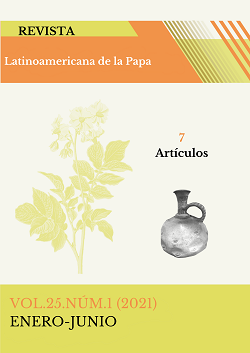Reproductive parameters of Tecia solanivora (Povolný, 1973) (Lepidoptera: Gelechiidae) in potato genotypes (Solanum tuberosum)
##plugins.themes.bootstrap3.article.main##
Abstract
The Guatemalan potato moth Tecia solanivora is the main pest of potato crop in Colombia. In 2003, Agrosavia began the identification and selection of potato genotypes from the Central Colombian Collection (CCC) for T. solanivora resistance. In 2013 reciprocal diallelic crosses were carried out between commercial varieties and the Guatemalan moth resistant native genotypes. The objective of this study was to determine the effect of potato hybrids obtained from crosses, on T. solanivora demographic parameters under laboratory conditions. Five genotypes and two commercial varieties were evaluated in a non-choice trial, through the development of a life table with two consecutive cohorts. Genotypes 4-69, 23-31 and Perla Negra (PN) were found to cause the highest larval mortality (90, 98 and 98%); 23-31 and PN did not allow adults development. In genotypes 4-69 and 23-31, the net reproductive rate (Ro) (3.92 and 4.38) and the intrinsic rate of natural growth (rm) (0.030 and 0.035) decreased, and the initial population doubling time (TD) increased significantly (18,14 and 19,35). These results suggest that three of the evaluated genotypes could have attributes of resistance to T. solanivora due to the antibiosis mechanism by affecting its biology. This study contributes to the search for materials with resistance to the Guatemalan moth, a line of research for potato breeding in Colombia.
Additional Keywords: Guatemalan potato moth, life table, antibiosis, antixenosis, pest resistance.
Download Statistics
##plugins.themes.bootstrap3.article.details##

This work is licensed under a Creative Commons Attribution-NonCommercial-ShareAlike 4.0 International License.


 https://orcid.org/0000-0001-8608-816X
https://orcid.org/0000-0001-8608-816X